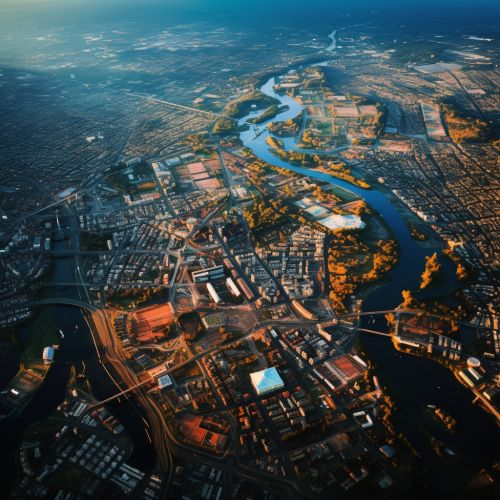Blue banana
Introduction
The Blue banana (also known as the European Megalopolis or the Manchester-Milan Axis) is a discontinuous corridor of urbanization spreading over Western and Central Europe. This region, characterized by higher population density and vast amounts of industrial production, extends approximately from North West England in the north to Northern Italy in the south. The term "Blue Banana" was coined in 1989 by RECLUS, a group of French geographers managed by Roger Brunet. Geographical and sociological factors play a significant role in the formation and development of the Blue Banana.
History
The concept of the Blue Banana began to emerge in the late 1980s. The French geographers identified a longitudinal zone in Europe with higher urbanization and industrialization than the rest of the continent. This area was shaped like a banana and was represented in blue on the maps, hence the term "Blue Banana" was coined. The Blue Banana concept was initially met with scepticism, but it has since gained acceptance and is now a well-established term in European urban studies.
Geographical Extent
The Blue Banana spans several countries and includes some of Europe's largest cities and industrial centres. It starts from North West England, encompassing the major cities of Manchester and Liverpool, and extends southwards through the Benelux countries, Western Germany, Eastern France, Switzerland, and Northern Italy, ending around Milan. This region is home to several major European metropolises such as London, Paris, Brussels, Cologne, Stuttgart, Munich, Zurich, and Milan. It also includes the heavily industrialized Ruhr and Rhine-Rhur regions in Germany, the Randstad in the Netherlands, and the Swiss Plateau.


Socioeconomic Characteristics
The Blue Banana is characterized by high population density, significant industrial production, and a high level of urbanization. It is home to several of Europe's largest and most influential cities, which serve as economic, political, and cultural hubs. The region is a major contributor to Europe's GDP and has a significant influence on the continent's economy. The Blue Banana is also characterized by a high level of education, with numerous prestigious universities and research institutions located in the region. The area is a hub for innovation and technological development, with a high concentration of high-tech industries.
Challenges and Criticisms
Despite its economic importance, the Blue Banana faces several challenges. These include issues related to urban sprawl, environmental degradation, and social inequality. The high level of urbanization and industrialization has led to significant environmental challenges, including air and water pollution, loss of biodiversity, and climate change. Furthermore, the concentration of wealth and resources in the Blue Banana has led to social and economic disparities within and between countries. Some critics argue that the concept of the Blue Banana oversimplifies the complex spatial dynamics of Europe and neglects other important regions.
Future Prospects
The future of the Blue Banana will be shaped by various factors, including demographic changes, economic trends, and environmental considerations. Efforts are being made to address the challenges faced by the region, including initiatives to promote sustainable development, improve social equity, and enhance regional integration. The Blue Banana continues to evolve and adapt to changing circumstances, and its role as a major European economic corridor is likely to continue in the future.
